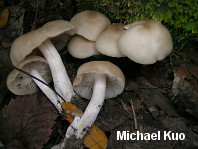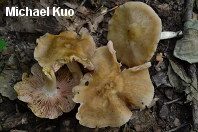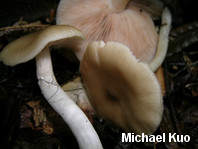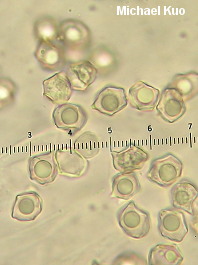| Major Groups > Gilled Mushrooms > Pink-Spored > Entolomatoid Mushrooms > Entoloma rhodopolium |

|
Entoloma rhodopolium [Basidiomycota > Agaricales > Entolomataceae > Entoloma . . . ] by Michael Kuo Members of the Entoloma rhodopolium species group are characterized by the following:
Like most other entolomatoid mushrooms, the species in this group have pink spore prints, grow on the ground, and have (under the microscope) angular spores. The taxonomy of this species group is problematic, and it is unclear whether any of our North American rhodopolium-like mushrooms are actually the same as the European species originally named by Elias Fries. In fact it is unclear whether the European mushrooms going under the name of Entoloma rhodopolium are all the same. According to the Dutch mycologist Machiel Noordeloos (1981), "[t]here is great need for neotypification of this classical Friesian species." Largent (1994) describes 6 "forms" of Entoloma rhodopolium from western North America, separated on minor morphological differences and ecological preferences. Description: Ecology: Saprobic; growing alone, scattered, or gregariously under hardwoods; late summer and fall (also over winter in California); widely distributed in North America. The collections described and illustrated here are from Illinois, Kentucky, and Missouri. Cap: 3-12 cm; convex, sometimes with a slight central bump, becoming broadly convex, broadly bell-shaped, or nearly flat; becoming thin and fragile; bald; sticky when fresh; tan to pale yellow-brown or pale grayish brown, fading and drying out to grayish or almost whitish; the margin faintly lined, at least by maturity. Gills: Attached to the stem; close or nearly distant; white at first, becoming pink with maturity. Stem: 4-10 cm long; 6-12 mm thick; more or less equal; fairly dry; bald, or very finely hairy at the apex; whitish; becoming hollow; basal mycelium white. Flesh: Thin; fragile; whitish to very pale tan; unchanging when sliced. Odor and Taste: Not distinctive, or mealy. Chemical Reactions: KOH on cap surface negative. Spore Print: Pink. Microscopic Features: Spores 8-11 x 5-8 µ; 5- to 8-sided; heterodiametric; smooth; inamyloid. Hymenial cystidia absent. Pileipellis a thin ixocutis of hyaline, non-encrusted elements. Clamp connections present. REFERENCES: (Fries, 1818) Kummer, 1871. (Fries, 1821; Saccardo, 1887; Kauffman, 1918; Hesler, 1967; Noordeloos, 1981; Arora, 1986; Noordeloos, 1988; Largent, 1994; Breitenbach & Kränzlin, 1995; McNeil, 2006; Noordeloos, 2008.) Herb. Kuo 08270219, 10010420, 09240504, 07090804, 09200811, 08081301. This site contains no information about the edibility or toxicity of mushrooms. |
© MushroomExpert.Com |
|
Cite this page as: Kuo, M. (2014, January). Entoloma rhodopolium. Retrieved from the MushroomExpert.Com Web site: http://www.mushroomexpert.com/entoloma_rhodopolium.html |



